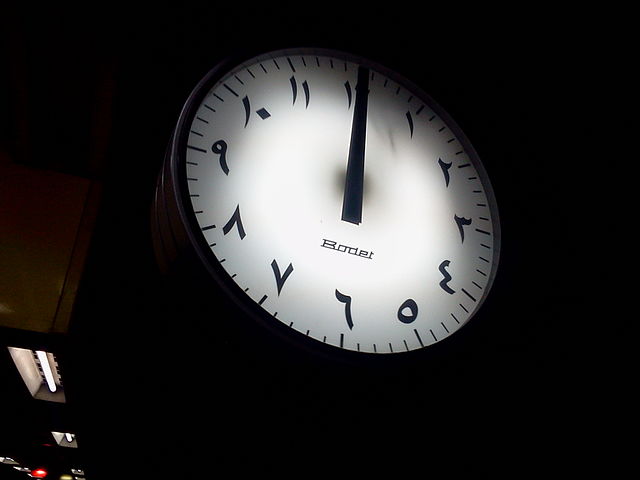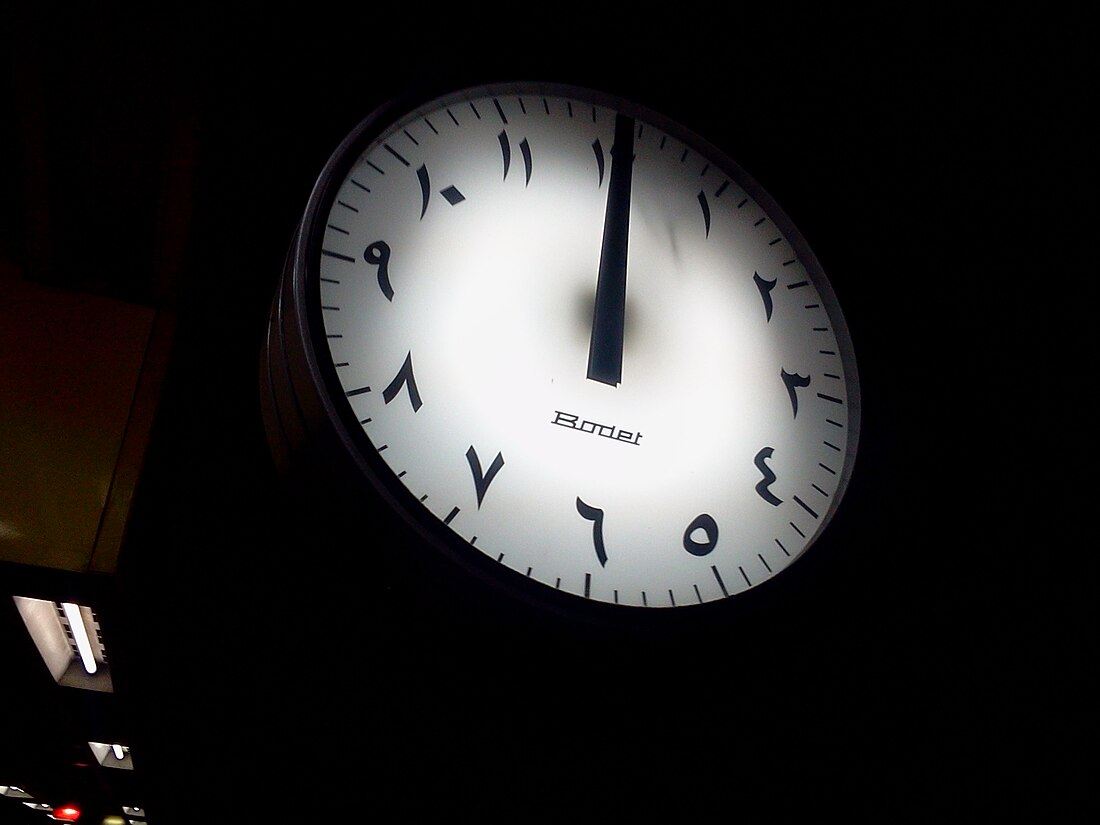Eastern Arabic numerals
Numerals used in the eastern Arab world and Asia From Wikipedia, the free encyclopedia
The Eastern Arabic numerals, also called Indo-Arabic numerals or Arabic-Indic numerals as known by Unicode, are the symbols used to represent numerical digits in conjunction with the Arabic alphabet in the countries of the Mashriq (the east of the Arab world), the Arabian Peninsula, and its variant in other countries that use the Persian numerals on the Iranian plateau and in Asia.



The early Hindu–Arabic numeral system used a variety of shapes.[1] It is unknown when the Western Arabic numeral shapes diverged from those of Eastern Arabic numerals; it is considered that 1, 2, 3, 4, 5, and 9 are related in both versions, but 6, 7 and 8 are from different sources.[2]
Origin
The numeral system originates from an ancient Indian numeral system, which was reintroduced during the Islamic Golden Age in the book On the Calculation with Hindic Numerals written by the Persian mathematician and engineer al-Khwarizmi, whose name was Latinized as Algoritmi.[note 1]
Other names
These numbers are known as ʾarqām hindiyyah (أَرْقَام هِنْدِيَّة) in Arabic. They are sometimes also called Indic numerals[3] or Arabic–Indic numerals[4] in English. However, that is sometimes discouraged as it can lead to confusion with Indian numerals, used in Brahmic scripts of the Indian subcontinent.[5]
Numerals
Summarize
Perspective
Each numeral in the Persian variant has a different Unicode point even if it looks identical to the Eastern Arabic numeral counterpart.[6] However, the variants used with Urdu, Sindhi, and other Languages of South Asia are not encoded separately from the Persian variants.
| Western Arabic | 0 | 1 | 2 | 3 | 4 | 5 | 6 | 7 | 8 | 9 | 10 |
| Eastern Arabic[a] | ٠ | ١ | ٢ | ٣ | ٤ | ٥ | ٦ | ٧ | ٨ | ٩ | ١٠ |
| Persian[b] | ۴ | ۵ | ۶ | ||||||||
| Urdu[c] | ۴ | ۶ | ۷ | ||||||||
| Abjad numerals | | ب | جـ | د | هـ | و | ز | حـ | ط | ى |
- U+06F0 to U+06F9. The numbers 4, 5, and 6 are different from Eastern Arabic.
- Same Unicode characters as the Persian, but language is set to Urdu. The numerals 4, 6 and 7 are different from Persian. On some devices, this row may appear identical to Persian. Commonly used in Pakistani languages.

Written numerals are arranged with their lowest-value digit to the right, with higher value positions added to the left. That is identical to the arrangement used for Western Arabic numerals, even though Arabic script is read from right-to-left.[7] Columns of numbers are usually arranged with the decimal points aligned.
Negative signs are written to the right of magnitudes, e.g. −٣ (−3).
In-line fractions are written with the numerator on the left and the denominator on the right of the fraction slash, e.g. ٢/٧ (2⁄7).
The Arabic decimal separator ٫ (U+066B) or the comma , is used as the decimal mark, as in ٣٫١٤١٥٩٢٦٥٣٥٨ (3.14159265358).
The arabic thousands separator ٬ (U+066C) or quote ' or Arabic comma ، (U+060C) may be used as a thousands separator, e.g. ١٬٠٠٠٬٠٠٠٬٠٠٠ (1,000,000,000).
Contemporary use
Summarize
Perspective


Eastern Arabic numerals are in predominant use over Western Arabic numerals in many countries to the east of the Arab world, notably Iran and Afghanistan.
In Arabic-speaking Asia, as well as Egypt and Sudan, both types of numerals are in use (and are often employed alongside each other), though Western Arabic numerals are increasingly used, including in Saudi Arabia. The United Arab Emirates uses both Eastern and Western Arabic numerals.
In Pakistan, Western Arabic numerals are more extensively used digitally. Eastern numerals continue to see use in Urdu publications and newspapers, as well as signboards.[clarification needed]
In the Maghreb, only Western Arabic numerals are commonly used. In medieval times, these areas used a slightly different set (from which, via Italy, Western Arabic numerals derive).
The Thaana writing system used for the Maldivian language adopted its first nine letters (haa, shaviyani, noonu, raa, baa, lhaviyani, kaafu, alifu, and vaavu) from Perso-Arabic digits.[8]
See also
Notes
- Other Latin transliterations include Algaurizin.[citation needed]
References
Wikiwand - on
Seamless Wikipedia browsing. On steroids.

